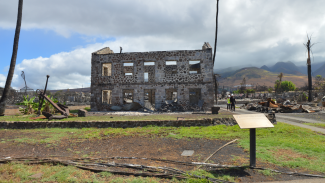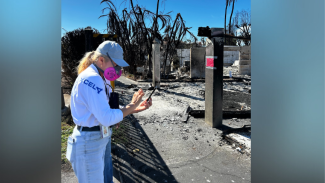
How architects are impacting rebuilding efforts in Hawaii
Architects have been instrumental in the efforts to rebuild in Maui following 2023 wildfires that caused immense damage on the island.
The August 2023 wildfires in Hawaii left an unfathomable trail of destruction in Maui, specifically the historic district of Lahaina. All told, the blazes destroyed more than 2,200 structures, caused about $5.5 billion in damages, and took the lives of more than 100 people. While plans to rebuild are slowly coming to fruition, many local architects have made an impact in relief efforts immediately following the fires and in the months since.
As soon as the fires were winding down, Julia Fink, executive vice president of AIA Honolulu, began figuring out how she could help her peers in Maui.
“I reached out to AIA Maui immediately and asked how we can help. We were trying to mobilize as fast as we could,” said Fink. “This is something that never really happened before, especially in Maui. It was a shock.”
Fink quickly worked to get members certified in structural assessment placarding. AIA Hawaii only had two members certified prior to the fires, but after getting three national trainers to come and volunteer their time, more than 80 members were certified.
“It was crazy and hectic, but it was well worth it. We got 30 volunteers over to Lahaina to do placarding in a month,” she said.
Each volunteer, an architect or licensed engineer, would go to every plot based on tax maps and review what was left of structures and check to see if each structure was safe to enter. A green placard out front meant one could enter the structure, a red placard meant one should stay out and a yellow placard meant to proceed with caution.

“It was devastating. For many of our members it was the first time they could see the site. No one really knew what was in the debris remaining,” said Fink. “Many members grew up in Lahaina or had family there. It was emotional and humbling, so many of the structures had nothing left to placard, but it was important to review—particularly the historic and cultural sites—to see if there was anything to be salvaged.”
According to the Lahaina Restoration Foundation, nearly all the district’s historic sites were destroyed in the fires. The Foundation is a 61-year-old nonprofit organization that, prior to the fires, was dedicated to managing 13 different historic sites around the district.
Naturally, since last August the work has changed significantly.
“We only have one building left,” said Theo Morrison, the executive director of the Lahaina Restoration Foundation. “All of our time and effort is now spent working with FEMA (the Federal Emergency Management Agency) and fundraising to try and restore our buildings. It’s going to take a very long time.”
According to Morrison, five of their buildings qualify for a FEMA public assistance program, where FEMA pays 90% of the restoration cost of those buildings. While 90% of the cost is a significant portion, Morrison estimates that each building may cost upwards of $10 million dollars to restore. “Ten percent of that is still a lot of money,” she said.
Morrison said that the county government is “understandably” putting most of their efforts into residential properties, and she notes that there isn’t much direction yet on how to proceed with rebuilding historic sites.

But Morrison is proceeding. She has requests out to architects to produce a master plan for the buildings that Lahaina Restoration wants to restore. “We need to know which permits are needed for which buildings, what buildings we should focus on first, that is where our focus is now.”
Despite the Herculean efforts that will be needed, Morrison is optimistic that Lahaina will recover, even if it isn’t immediate.
“The whole town is closed. I don’t think most people understand the magnitude of this disaster, everything that makes a town a town is gone. It’s just not there,” said Morrison. “I am very confident we will build back, but it is going to take longer than most people think.”
Fink echoes that sentiment. “We must come together and work together. Being an island community means we depend on each other whether we like it or not. It’s going to take time to rebuild, but seeing everyone come together has been special, but not surprising. It’s something we do; it’s engrained in us.”
Ohana Hope Village
Following the fires, David Sellers, president of AIA Maui and principal architect at Hawaii Off-Grid (HIOG), a Maui-based architecture firm, worked quickly with the Family Life Center, an organization founded in 1982 “out of response to increasing demand for in the community to provide social services” across Maui, to establish the Ohana Hope Village, a temporary housing development for those displaced by the disaster.
Located on a ten-acre parcel, the project fits 88 dwelling units, Sellers says the concept behind the project was to be “conscious of our culture.”
“The idea of a village was our theme. We have a maximum of six dwellings surrounding one community center. Ideally the dwellings are occupied by a multi-generational family, which is also responding to our local culture and community,” Sellers said.
According to the Ohana Hope Village website, the community centers feature “communal laundry facilities, private meeting space, a large kitchen and dining space perfect for those large family gatherings.” Sixteen of these community centers are laid out across the 88 dwelling units.
“So far ten of these homes are move-in ready right now and six we’re just finishing up. We’ve been ready for several months to move people, but we are an example of why we have a housing crisis in this country. There is a lack of infrastructure. The government can’t move fast enough to do what it’s supposed to do,” said Sellers. “The state, the county, I was just in a meeting about FEMA housing, they’re just starting to break ground and we’re ready to move in. If we had the funding, we could have moved people in a lot longer ago.”
Sellers cites infrastructure issues, including the inability to handle sewage and provide water, as roadblocks.
“It’s a microcosm of all the issues of why we don’t have a lot of housing in Hawaii and it’s representative of a lot of other places. The lack of infrastructure for water and wastewater, and it’s not that there’s a lack of water. We’re not talking about arid desert; we have one of the wettest places on the planet in the West Maui mountains. It’s a lack of people doing things,” Sellers said. “Our communities deserve better, our kids deserve better, and we can do better. We’ve created the problem, which means we can create the solution.”
Donate to Ohana Hope Village here.
Donate to Lahaina Restoration Foundation here.
